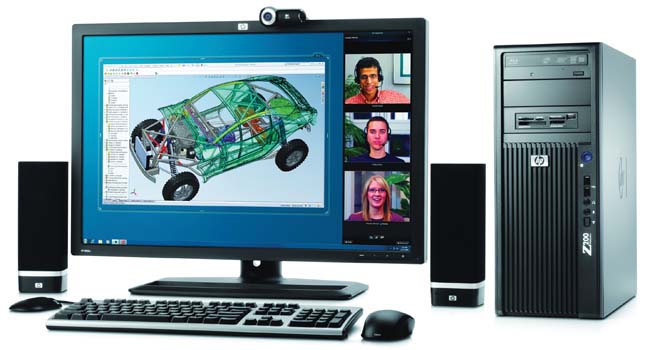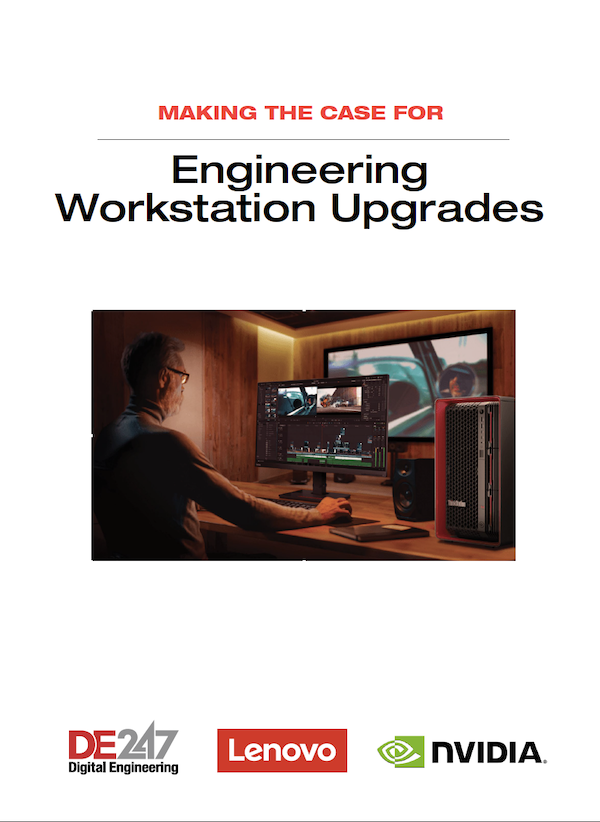HP Z200 Brings Power to the People
HP's entry-level CAD workstation is big on performance and easy on your wallet.
Latest News
December 4, 2001
By David Cohn
Earlier this year, HP introduced the Z200, the newest member of its Z-series workstations. Targeted at entry-level CAD users, prices start at $769, making the Z200 one of the most affordable systems out there certified for use with CAD applications.
 Our HP Z200 evaluation unit turned in some of the best test results ever, making this system a performance leader. |
The HP Z200 we received came housed in a newly designed case that bears considerable resemblance to the BMW Designworks styling we first saw in the flagship HP Z800 we reviewed earlier this year (DE January 2010). While its lineage is apparent, the Z200’s configuration is more conventional, with three 5.25-in. drive bays with exposed front panel access. The top-most bay contains a tray-loading 16X SATA dual-layer SuperMulti LightScribe DVD+/-RW optical drive, while the lower bay houses a 22-in-1 media card reader. These bays can be rotated 90° to convert from a minitower to a desktop configuration and a Blu-ray writer is available as an option.
HP Workstation Z200 At-a-Glance • Price: $2,089 as tested ($729 base price) |
Below these bays, vertical fins conceal the air intake and internal speaker while a power button, two USB ports, headphone and microphone jacks, and an IEEE 1394a FireWire connector occupy a narrow vertical panel down the right side. The rear panel adds six more USB 2.0 slots, PS/2 keyboard and mouse connectors, an RJ-45 jack for the integrated Intel 82578 Gigabit LAN, and audio-in, audio-out, and microphone jacks. There are also DVI-I and DisplayPort connectors for the integrated Intel graphics.
Plenty of Expansion Options
Removing the side panel on the tool-less chassis reveals the clean interior we’ve come to expect from HP, although a far cry from the modular organization of the flagship Z800. Below the external drive bays are three 3.5-in. bays, one of which contained a Western Digital 500GB 7,200 rpm SATA drive. Drives of up to 1.5TB are available, and HP also offers solid-state drives.
CPU options for the Z200 range from a 2.56GHz Celeron up to a 3.6GHz dual-core i5 or a 3.06GHz Xeon quad-core processor. Our evaluation unit came with a 3.47GHz Intel i5-670 dual-core CPU with 4MB of L2 cache mounted in the single CPU socket. One of Intel’s newest 32 nanometer CPUs, the 670 has a maximum Thermal Design Power of 73 watts, a maximum turbo-boost frequency of 3.73GHz, and it supports HyperThreading. Our system also included 4GB of 1,333MHz DDR-3 memory, installed as a pair of 2GB DIMMs, leaving two additional memory sockets available for future expansion. The Z200 supports up to 16GB of RAM. Power was provided via a 320 watt 89% efficient power supply.
The motherboard provides seven slots: one PCIe Gen2 x16 graphics slot, one PCIe Gen1 x1 slot, one PCIe Gen1 x4 slot (x1 electrically), one PCIe Gen1 x16 slot (x4 electrically), and three full-length PCI slots. The graphics slot was filled with an NVIDIA Quadro FX 1800 graphics accelerator with 768MB of memory. There are also up to five more internal USB ports available. Despite fans on the graphics card, CPU, power supply, and rear panel, the Z200 was virtually silent.
Excellent Performance
While the Intel i5-670 is a pretty fast processor, it’s only a dual-core CPU, so we were not expecting to see any records fall. Boy, were we surprised. On the SPECopc Viewperf graphics benchmark, the HP Z200 equipped with the NVIDIA Quadro FX 1800 graphics card turned in some of the fastest results we’ve ever recorded on three of the datasets and very respectable results on the others.
On the SPECapc SolidWorks benchmark, which is more of a real-world test (and breaks out graphics, CPU, and I/O performance separately from the overall score), the Z200 results were a bit lower, reflecting its more modest components. But even on this test, this affordable HP workstation yielded great results, including the best I/O performance we’ve seen to date.
The AutoCAD rendering test results were also excellent, although definitely well behind those of the hyper-threaded dual-quad-core equipped systems we’ve recently reviewed. Because AutoCAD’s mental ray rendering engine is multi-threaded, this test clearly shows the benefits of multiple cores. The Z200 averaged 135 seconds to complete the test rendering, just 10 seconds behind the Dell T3500 despite having half the number of CPU cores.
HP rounds out the Z200 with its excellent 104-key USB keyboard and a two-button optical mouse and backs the system with a limited 3-year warranty on parts and labor.
While Z200 prices start at just $729, at that price you get a Celeron CPU, 2GB of memory, integrated graphics, and a relatively small hard drive. This spring, HP also released a small form factor version of the Z200, with prices starting even lower at $699. Adding options obviously boosts the price, but even at $2,089 as tested, our HP Z200 evaluation unit delivers plenty of power without breaking the bank. It may just be the best balance of engineering workstation power and performance available today.
More Info:
HP
David Cohn is a computer consultant and technical writer based in Bellingham, WA and has been benchmarking PCs since 1984. He’s a contributing editor to Desktop Engineering, the former editor-in-chief of Engineering Automation Report and CADCAMNet, and the author of over a dozen books. You can contact him via email at [email protected] or visit his website at www.dscohn.com.
Subscribe to our FREE magazine, FREE email newsletters or both!
Latest News
About the Author
David Cohn is a consultant and technical writer based in Bellingham, WA, and has been benchmarking PCs since 1984. He is a Contributing Editor to Digital Engineering, the former senior content manager at 4D Technologies, and the author of more than a dozen books. Email at [email protected] or visit his website at www.dscohn.com.
Follow DE





